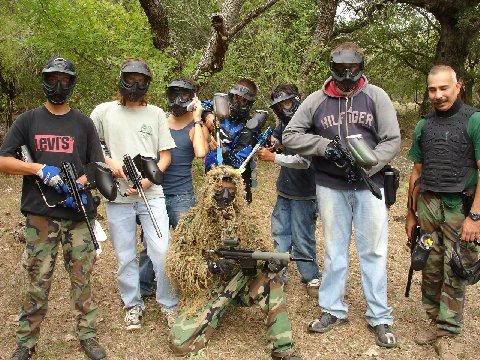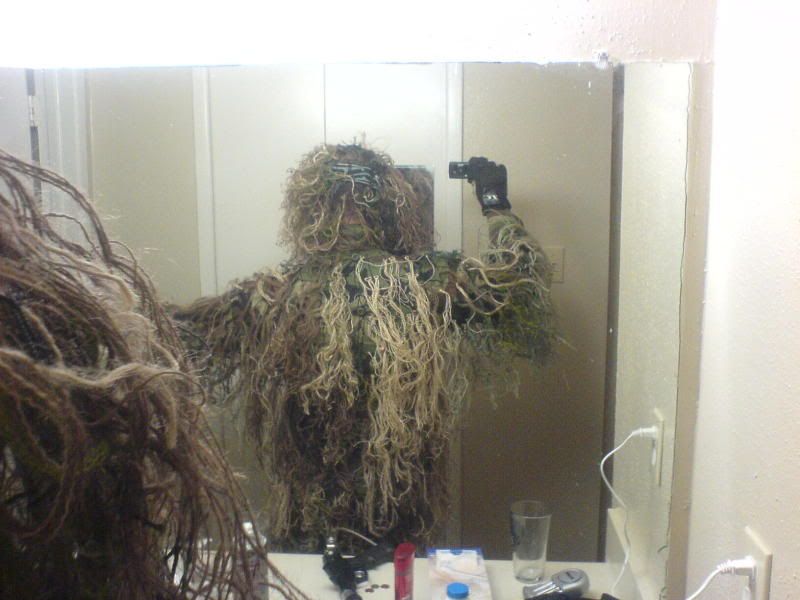Post by lordkyleofearth on Apr 6, 2013 9:37:39 GMT -5
[disclaimer] I apologize for the quality of some of the photos here. Photobucket seems to have 'adjusted' them at some point  [/disclaimer]
[/disclaimer]
When I made my first ghillie suit I was amazed at how well it allowed me to hide in the South Texas countryside. I took great pains to ensure that the colors I chose were well matched to the area where we played and that I had plenty of places on the suit where local vegetation could be worked in.

However, when I played at different fields, I found that the suit didn't blend quite as well. It was still sufficient, but to my trained eye it was noticeably more obvious. Then the seasons changed and I found myself the owner of an essentially useless suit.

I knew that the extreme green hues of spring would fade quickly and restore my suit to usefulness, but spring is the best time to play in this area (it's not 115*F outside). I also came to realize that after several seasons of use, my suit had begun to get pretty worn down.

I needed to replenish my suit's burlap supply which was almost more difficult than making a new suit, because I had to try and determine how much material to add, where to add it, and what colors to use (without throwing off the color scheme). There had to be a better way, so I set out to find it.
What I decided I needed was one ghillie that could work in all conditions, at any field, in any season. I also wanted to be able to reconfigure the suit depending on the role I expected to play at a given game (change between full coverage, stalker style, back only, etc.) Because I would rather play paintball than sit in a field messing with fabric and grass, I also wanted the suit's modifications to take less than 30 mins to complete.
In the end, a modular ghillie was really my only option. I decided to make 6" panels of ghillie material on 1" square mesh netting. These panels would be fastened to a base layer made from a BDU jacket and pants. Once I arrived at a game I would simply select panels that met the native environment, fasten them to the base, and then blend in native material.
While a velcro fastener would have been the fastest, cheapest, and easiest, option I had witnessed first hand how quickly burlap fibers had killed the velcro on my gloves, so it wasn't an option. After weighing my options I made the determination that a button fastened suit would be the cheapest, easiest, and most durable option.

Because button holes are a pain in the *** to sew, I decided to use elastic banding as the fastener for the buttons. This also gave an added bit of flexibility in the event of a snag. To attach a panel, I would simply place the corner square of each panel over the button, then loop the elastic over the top of that.

If I wanted to leave the front barren (because I was anticipating lots of low crawls) or if I decided to not cover my legs (due to dense brush in the area), I just didn't add panels in that region.
Coverage with this modular system was identical to my previous efforts. After field testing it multiple times, I've had no issues with panels coming free during a game. People routinely fail to spot me at close ranges, I only have to maintain a single suit, and seasonal/geographic changes no longer diminish the suit's abilities.

My next modification is going to be an active cooling/ventilation system. I currently have to drink about one quart of water every ten mins during the summer, and water transportation has become my greatest limiter in the field.
 [/disclaimer]
[/disclaimer]When I made my first ghillie suit I was amazed at how well it allowed me to hide in the South Texas countryside. I took great pains to ensure that the colors I chose were well matched to the area where we played and that I had plenty of places on the suit where local vegetation could be worked in.

However, when I played at different fields, I found that the suit didn't blend quite as well. It was still sufficient, but to my trained eye it was noticeably more obvious. Then the seasons changed and I found myself the owner of an essentially useless suit.

I knew that the extreme green hues of spring would fade quickly and restore my suit to usefulness, but spring is the best time to play in this area (it's not 115*F outside). I also came to realize that after several seasons of use, my suit had begun to get pretty worn down.

I needed to replenish my suit's burlap supply which was almost more difficult than making a new suit, because I had to try and determine how much material to add, where to add it, and what colors to use (without throwing off the color scheme). There had to be a better way, so I set out to find it.
What I decided I needed was one ghillie that could work in all conditions, at any field, in any season. I also wanted to be able to reconfigure the suit depending on the role I expected to play at a given game (change between full coverage, stalker style, back only, etc.) Because I would rather play paintball than sit in a field messing with fabric and grass, I also wanted the suit's modifications to take less than 30 mins to complete.
In the end, a modular ghillie was really my only option. I decided to make 6" panels of ghillie material on 1" square mesh netting. These panels would be fastened to a base layer made from a BDU jacket and pants. Once I arrived at a game I would simply select panels that met the native environment, fasten them to the base, and then blend in native material.
While a velcro fastener would have been the fastest, cheapest, and easiest, option I had witnessed first hand how quickly burlap fibers had killed the velcro on my gloves, so it wasn't an option. After weighing my options I made the determination that a button fastened suit would be the cheapest, easiest, and most durable option.

Because button holes are a pain in the *** to sew, I decided to use elastic banding as the fastener for the buttons. This also gave an added bit of flexibility in the event of a snag. To attach a panel, I would simply place the corner square of each panel over the button, then loop the elastic over the top of that.

If I wanted to leave the front barren (because I was anticipating lots of low crawls) or if I decided to not cover my legs (due to dense brush in the area), I just didn't add panels in that region.
Coverage with this modular system was identical to my previous efforts. After field testing it multiple times, I've had no issues with panels coming free during a game. People routinely fail to spot me at close ranges, I only have to maintain a single suit, and seasonal/geographic changes no longer diminish the suit's abilities.

My next modification is going to be an active cooling/ventilation system. I currently have to drink about one quart of water every ten mins during the summer, and water transportation has become my greatest limiter in the field.



